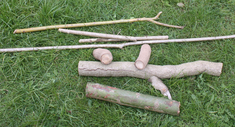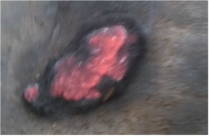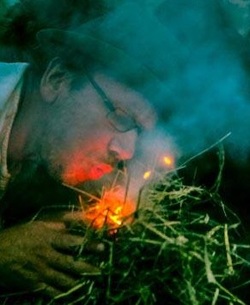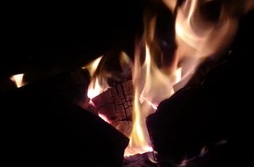Ritual Welcoming of Fire
A few suggestions for ritual fires:
I am not going to mandate any way to ritually welcome fire, or how to conduct fire ceremonies as I do not attach myself to any particular religion, doctrine or tradition and I do not perform rituals from other traditions (as I personally see that as appropriation) but have made a few suggestions below. My fire rituals are my own personal way of honouring the ancestral fire.
Ritual can be influenced by time of year / beliefs / spiritual path / the land/ nature/ local customs/folklore / a theme / a crisis etc etc that can all be weaved in . Traditionally the Neid Fire ritual was for use in time of need and auspicious events.
The language of fire is important to me. I coax th embryonic ancestral fire out of hiding from the wood by rubbing sticks as is told by the old stories.
I welcome fire into being through breath
I welcome fire with a deep connection, with intention, awareness and reverence. Many stories and legends tell of how fire was hidden in the wood and the only way to coax fire out of hiding from the wood was through rubbing the wood together. Other phrases could be "kindling of fire", "birthing of fire", "invocation of fire" or "churning of fire"
I am also an apprentice of fire (I shall never be a master) and I tend to the ancestral fire
I Vedism Agni was seen to be born through the frcition of the male fire stick (spindle) and female fire stick (hearth)
One of the key things about any ritual practice is doing it with intention and awareness.
Ritual can be influenced by time of year / beliefs / spiritual path / the land/ nature/ local customs/folklore / a theme / a crisis etc etc that can all be weaved in . Traditionally the Neid Fire ritual was for use in time of need and auspicious events.
The language of fire is important to me. I coax th embryonic ancestral fire out of hiding from the wood by rubbing sticks as is told by the old stories.
I welcome fire into being through breath
I welcome fire with a deep connection, with intention, awareness and reverence. Many stories and legends tell of how fire was hidden in the wood and the only way to coax fire out of hiding from the wood was through rubbing the wood together. Other phrases could be "kindling of fire", "birthing of fire", "invocation of fire" or "churning of fire"
I am also an apprentice of fire (I shall never be a master) and I tend to the ancestral fire
I Vedism Agni was seen to be born through the frcition of the male fire stick (spindle) and female fire stick (hearth)
One of the key things about any ritual practice is doing it with intention and awareness.

Preparation
Preparation is very important for ritual fire especially if adopting the Neid Fire practice (I will be adding a separate article)
It takes time to find suitable wood and season and prepare.
For other methods I take time to find the materials and season and prepare them with awareness and intention.
I like to prepare the fire wood, tinder bundle, materials and kit with awareness and intention, and you may like to make blessings\offerings as you gather and prepare materials and give thanks for what you have taken.
The choice of fire wood and wood for use in the friction set may also be important to you. I like to choose native local woods where possible (to where the fire is being sited) and to use dead dry woods with good burning properties - please see this blog post for some suggestions of fire wood. Again a specific type of fire wood may be important.
I collect wood which has already fallen - I don't cut live trees and I don't advocate cutting of live trees unless over abundnt and done in a sustainable and honourable way.
You may also want to think about the woods to use in the friction set - here are some good combinations for the bow drill (dill / hearth) - Hazel on Hazel, Hazel on Ash, Ash on Ash, Hazel/Willow on Willow, Hazel on Lime/Poplar, Oak on Oak (Oak does work but takes a bit more preparation and patience.) Again if possible you may want to use woods local and native to where the ritual is taking place (this may not always be possible though.)
Oak was commonly used by the Celts and Slavs in kindling the Neid Fire, Banyan used in Vedic fire rituals and the Greeks used Ivy and Bay Laurel. Only collect Oak from wind fallen branches/trees
You may also like to prepare the fire pit in advance and have all the fire wood needed for the duration of the fire ready prepared. Or you may want to make and prepare the fire pit as part of the ceremony itself. I suggest a clean fire pit with no rubbish, no metal or stones in the base.
Preparation is very important for ritual fire especially if adopting the Neid Fire practice (I will be adding a separate article)
It takes time to find suitable wood and season and prepare.
For other methods I take time to find the materials and season and prepare them with awareness and intention.
I like to prepare the fire wood, tinder bundle, materials and kit with awareness and intention, and you may like to make blessings\offerings as you gather and prepare materials and give thanks for what you have taken.
The choice of fire wood and wood for use in the friction set may also be important to you. I like to choose native local woods where possible (to where the fire is being sited) and to use dead dry woods with good burning properties - please see this blog post for some suggestions of fire wood. Again a specific type of fire wood may be important.
I collect wood which has already fallen - I don't cut live trees and I don't advocate cutting of live trees unless over abundnt and done in a sustainable and honourable way.
You may also want to think about the woods to use in the friction set - here are some good combinations for the bow drill (dill / hearth) - Hazel on Hazel, Hazel on Ash, Ash on Ash, Hazel/Willow on Willow, Hazel on Lime/Poplar, Oak on Oak (Oak does work but takes a bit more preparation and patience.) Again if possible you may want to use woods local and native to where the ritual is taking place (this may not always be possible though.)
Oak was commonly used by the Celts and Slavs in kindling the Neid Fire, Banyan used in Vedic fire rituals and the Greeks used Ivy and Bay Laurel. Only collect Oak from wind fallen branches/trees
You may also like to prepare the fire pit in advance and have all the fire wood needed for the duration of the fire ready prepared. Or you may want to make and prepare the fire pit as part of the ceremony itself. I suggest a clean fire pit with no rubbish, no metal or stones in the base.
Holding the ceremonial space
As with any ritual\ceremony it is common for the ritual and space to be "held" .
In bushcraft, the lighting of the fire is seen more of an individual's role but in ritual it is common across many traditions for it to be a more shared\communal role.
In the early days of welcoming fire within ceremony I would be the sole "fire starter" with everyone watching me - after doing this a few times I wasn't happy with that approach. Now I prefer to involve others in the process so it is a more communal approach.
It may be prudent to allocate "roles" beforehand such as those who wi'l be involved in preparing and kindling the fire, and fire keepers (I don't particularly like that phase either as you are tending the fire rather than keeping it. You could say the fire is the keeper of us ! )
As with any ritual\ceremony it is common for the ritual and space to be "held" .
In bushcraft, the lighting of the fire is seen more of an individual's role but in ritual it is common across many traditions for it to be a more shared\communal role.
In the early days of welcoming fire within ceremony I would be the sole "fire starter" with everyone watching me - after doing this a few times I wasn't happy with that approach. Now I prefer to involve others in the process so it is a more communal approach.
It may be prudent to allocate "roles" beforehand such as those who wi'l be involved in preparing and kindling the fire, and fire keepers (I don't particularly like that phase either as you are tending the fire rather than keeping it. You could say the fire is the keeper of us ! )

Coaxing the Embryonic ancestral fire out of hiding from The Wood
Through my research, it seems that across many traditions there is a commonality that is the use of Friction Fire for ritual \ sacred fires. I have not yet come across the use of other methods such as striking flints. In the Vedic fire rituals they still use friction fire today in places. And in many traditions, it is more of a communal activity rather than just one person.
I recommend to start with the bow drill as a friction method and still it can take time to learn and perfect (see Learning Methods.) Do use natural cordage with the bow drill for ritual (you can buy good flax \ sisal cordage rather than making your own cordage at first - but for ritual I make my own nettle cordage.)
I personally dislike the use of modern Ferro rods as they are man made of alloys and produce very hot metal sparks - fire by friction was part of the cultural heritage in the UK for ritually welcoming fire for hundreds of years and is the way I encourage others to use in ritual.
We have lost the knowledge which I aim to pass on!
I do not use any other method for welcoming fire in ritual
Working together is important for me ....
With the hand drill people can take turns spinning the drill - and indeed everyone could take a turn
with the bow drill, several people can easily be involved with it - someone holding the bearing block, 2 people using the bow etc and taking turns
with the Neid Fire everyone is involved in welcoming the fire - I will be adding more articles on Neid Fire
with ritual it's not about speed or efficiency, but more about welcoming the fire with intention, focus and awareness and theatrics is seen by some as a vital ingredient in ritual so nothing wrong with a few failed attempts (and if it's going too well you may well want to faili on purpose....)
Whilst the ritual of coaxing the embryonic fire out of hiding is in progress, I prefer that the others not involved , to focus their intention on the ritual and to be aware and maybe say blessings either quietly or out loud. I prefer all awareness and intention to be focused on the welcoming of the fire, and no other chatter \ distractive activity etc whilst it is in progress. You may want to do it in grand ceremony; give thanks or blessings ; or in reflective solitude. The Vedic Agni Manthan rituals are accompanied by chanting of the Vedic hymns associated with the ritual.
With Neid Fire you may want to incorporate song or a chant
Through my research, it seems that across many traditions there is a commonality that is the use of Friction Fire for ritual \ sacred fires. I have not yet come across the use of other methods such as striking flints. In the Vedic fire rituals they still use friction fire today in places. And in many traditions, it is more of a communal activity rather than just one person.
I recommend to start with the bow drill as a friction method and still it can take time to learn and perfect (see Learning Methods.) Do use natural cordage with the bow drill for ritual (you can buy good flax \ sisal cordage rather than making your own cordage at first - but for ritual I make my own nettle cordage.)
I personally dislike the use of modern Ferro rods as they are man made of alloys and produce very hot metal sparks - fire by friction was part of the cultural heritage in the UK for ritually welcoming fire for hundreds of years and is the way I encourage others to use in ritual.
We have lost the knowledge which I aim to pass on!
I do not use any other method for welcoming fire in ritual
Working together is important for me ....
With the hand drill people can take turns spinning the drill - and indeed everyone could take a turn
with the bow drill, several people can easily be involved with it - someone holding the bearing block, 2 people using the bow etc and taking turns
with the Neid Fire everyone is involved in welcoming the fire - I will be adding more articles on Neid Fire
with ritual it's not about speed or efficiency, but more about welcoming the fire with intention, focus and awareness and theatrics is seen by some as a vital ingredient in ritual so nothing wrong with a few failed attempts (and if it's going too well you may well want to faili on purpose....)
Whilst the ritual of coaxing the embryonic fire out of hiding is in progress, I prefer that the others not involved , to focus their intention on the ritual and to be aware and maybe say blessings either quietly or out loud. I prefer all awareness and intention to be focused on the welcoming of the fire, and no other chatter \ distractive activity etc whilst it is in progress. You may want to do it in grand ceremony; give thanks or blessings ; or in reflective solitude. The Vedic Agni Manthan rituals are accompanied by chanting of the Vedic hymns associated with the ritual.
With Neid Fire you may want to incorporate song or a chant

Breathing into the Fire - Welcoming the Fire through Breath
Once you have coaxed the embryonic fire from the wood, you then need to feed the ember with tinder and breath, to welcome the fire into being. I like to use a nice big bundle of very dry dead materials such as bracken and willowherb seed heads, and place the embryonic fire in the middle with care and awareness, and then caress it with your breath to welcome in the fire
It can be very powerful and moving to invite everyone to breathe into the tinder bundle, or ask everyone to make a collective symbolic breath towards the bundle .
Once you have coaxed the embryonic fire from the wood, you then need to feed the ember with tinder and breath, to welcome the fire into being. I like to use a nice big bundle of very dry dead materials such as bracken and willowherb seed heads, and place the embryonic fire in the middle with care and awareness, and then caress it with your breath to welcome in the fire
It can be very powerful and moving to invite everyone to breathe into the tinder bundle, or ask everyone to make a collective symbolic breath towards the bundle .

Tending the Fire
Once fire has been welcomed into being, it then needs to be fed with small very dry kindling and then gradually add gradually bigger pieces of wood to the fire (again with awareness and attention rather than throwing it onto the fire...)
With Neid Fire I like to prepare a bonfire and make a space for the tinder bundle
To keep the ritual fire clean and pure and to respect the fire it is recommended that no rubbish is put on the fire including cigarettes, paper, tissues, card, plastic etc.
However, you may like to ask people to place offerings on the fire such as chocolate or whiskey or incense and say a blessing
If you are in sacred\ceremonial space overnight or a few days then tending a fire through vigil can be very powerful and to keep the fire burning for the duration. If the fire does die out, then you may want to first try using the embers from the fire before starting again to tempt the ember from the wood.
Cooking on fire is a beautiful way to honour the fire - I prefer to first ritually cook direct on the flames (e.g. halloumi or steak) and feed the first piece to the fire before then offering around and cooking anything else on the fire.
Once fire has been welcomed into being, it then needs to be fed with small very dry kindling and then gradually add gradually bigger pieces of wood to the fire (again with awareness and attention rather than throwing it onto the fire...)
With Neid Fire I like to prepare a bonfire and make a space for the tinder bundle
To keep the ritual fire clean and pure and to respect the fire it is recommended that no rubbish is put on the fire including cigarettes, paper, tissues, card, plastic etc.
However, you may like to ask people to place offerings on the fire such as chocolate or whiskey or incense and say a blessing
If you are in sacred\ceremonial space overnight or a few days then tending a fire through vigil can be very powerful and to keep the fire burning for the duration. If the fire does die out, then you may want to first try using the embers from the fire before starting again to tempt the ember from the wood.
Cooking on fire is a beautiful way to honour the fire - I prefer to first ritually cook direct on the flames (e.g. halloumi or steak) and feed the first piece to the fire before then offering around and cooking anything else on the fire.
Extinguishing the Fire
In some traditions, the fire was left to die out naturally rather than be put out but this all depends on the situation and surroundings - don't leave the fire to die out unattended, especially if in the wilds or public space. Extinguishing the fire can still be done ritually with awareness and either quietly or with words. You could ask everyone to pour some water on and give thanks as they are doing so.
In some traditions, the fire was left to die out naturally rather than be put out but this all depends on the situation and surroundings - don't leave the fire to die out unattended, especially if in the wilds or public space. Extinguishing the fire can still be done ritually with awareness and either quietly or with words. You could ask everyone to pour some water on and give thanks as they are doing so.